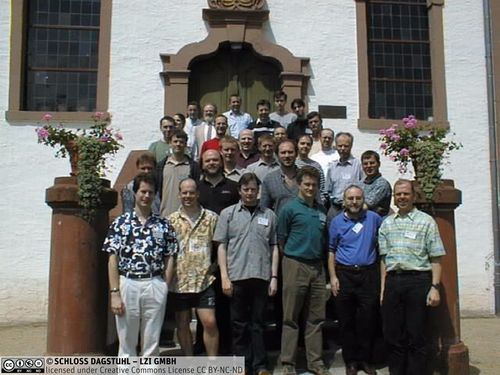Dagstuhl Seminar 01242
Stochastic Methods in Rendering
( Jun 10 – Jun 15, 2001 )
Permalink
Organizers
- Werner Purgathofer (TU Wien, AT)
- Mateu Sbert (University of Girona, ES)
- Pete Shirley (University of Utah - Salt Lake City, US)
Contact
Impacts
- Combined correlated and importance sampling in direct light source computation and environment mapping : article : S. 585-593 - Szecsi, Laszlo; Sbert, Mateu; Szirmay-Kalos, Laszlo - Oxford : Blackwell, 2004 - (Computer graphics forum : 23. 2004, 3 : S. 585-593). DOI: 10.1111/j.1467-8659.2004.00790.x.
- Efficient Multidimensional Sampling : article in EUROGRAPHICS 2002 - Kollig, Thomas; Keller, Alexander - Aire-la-Ville : Eurographics Association, 2002. - 7 pp..
Stochastic techniques have become indispensable tools in Computer Graphics, and more specifically in rendering, since the mid 1980s. Now stochastic techniques are used in all subfields of rendering, and are part of every major commercial rendering package. Despite this, there has never been a scientific meeting on the use of such techniques for graphics applications.
As with most Computer Graphics research, work from related fields such as Radiative Heat Transfer and Neutron transport have been modified and applied in Computer Graphics rendering. Several of these so-called Monte Carlo techniques were originally developed for military purposes, such as efficient algorithms for determining trajectories of atomic particles, which were actively researched over many years. However, this origination from within the military-scientific world has given stochastic techniques a bit of an occult flavour. Some papers have to be literally undug from obscure and/or previously classified sources, researchers from beyond the iron curtain independently developed similar techniques to western ones, and the security-motivated lack of an open research community has meant that results were rediscovered again and again over the years. In practice this means that, to an even worse extent than in other branches of science, one can never be too sure to have found the first reference for a given result, or that the results that one has obtained are really original.
Secondly, however, once the basic technique is introduced in CG, its researchers often improve on it in such a way that sometimes it is transferred back to the field from where it was borrowed, as it has happened with some RHT methods. In recent years, researchers have investigated the advantages of quasi Monte Carlo methods, which extend the properties of pure stochastic approaches to deterministic algorithms.
Although specific conferences exist separately on Monte Carlo techniques and Rendering, they are both too general to give an opportunity to Monte Carlo researchers in Rendering for meeting and evaluating the specific impact of these techniques on their field. As outlined above, the characteristics of this field, together with its heavy impact on today's Computer Graphics research, calls for a meeting of the research community.
The purpose of this seminar is thus to give the opportunity to evaluate the past, present and future perspectives of the use of stochastic and quasi-Monte Carlo techniques in Rendering.
- György Antal (Budapest University of Technology & Economics, HU)
- David Banks (Florida State University, US)
- Philippe Bekaert (Hasselt University - Diepenbeek, BE) [dblp]
- Gonzalo Besuievsky (University of Girona, ES)
- Jiri Bittner (Czech Technical University, CZ)
- Francesc Castro (University of Girona, ES)
- Alan Chalmers (University of Bristol, GB)
- Per Christensen (Pixar - Seattle, US)
- Kirill Alexandrovich Dimitziev (MPI für Informatik - Saarbrücken, DE)
- Miquel Feixas (University of Girona, ES)
- Hans Hagen (TU Kaiserslautern, DE) [dblp]
- John H. Halton (University of North Carolina at Chapel Hill, US)
- Vincent Jolivet (University of Limoges, FR)
- Alexander Keller (NVIDIA GmbH - Berlin, DE) [dblp]
- Thomas Kollig (TU Kaiserslautern, DE)
- Heinrich Müller (TU Dortmund, DE)
- Karol Myszkowski (MPI für Informatik - Saarbrücken, DE)
- Attila Neumann (TU Wien, AT)
- László Neumann (University of Girona, ES)
- Jan Prikryl (VRVis - Wien, AT)
- Werner Purgathofer (TU Wien, AT)
- Mateu Sbert (University of Girona, ES)
- Heidrun Schumann (Universität Rostock, DE) [dblp]
- Hans-Peter Seidel (MPI für Informatik - Saarbrücken, DE) [dblp]
- Philipp Slusallek (Universität des Saarlandes, DE) [dblp]
- Frank Suykens (KU Leuven, BE)
- László Szirmay-Kalos (Budapest University of Technology and Economics, HU)
- Robert F. Tobler (VRVis - Wien, AT)
- Carlos Ureña (Universidad de Granada, ES)
- Ingo Wald (University of Utah, US) [dblp]
- Alexander Wilkie (TU Wien, AT)
- Michael Wimmer (TU Wien, AT)


